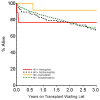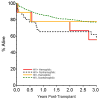Hemophilia Liver Transplantation Observational Study
- PMID: 27935212
- PMCID: PMC5449207
- DOI: 10.1002/lt.24688
Hemophilia Liver Transplantation Observational Study
Abstract
Hepatitis C virus (HCV) infection is the leading cause of liver disease in hemophilia patients. In those with human immunodeficiency virus (HIV)/HCV coinfection, the rate of liver disease progression is greater than in HCV monoinfected individuals. Despite antiretroviral therapy, which slows HCV liver disease progression, some require transplantation. Whether transplant outcomes are worse in hemophilic (H) rather than nonhemophilic (NH) candidates is unknown. In order to determine rates and predictors of pretransplant and posttransplant survival, we conducted a retrospective observational study using United Network for Organ Sharing national transplant registry data, comparing HCV+ H and NH candidates. We identified 2502 HCV+ liver transplant candidates from 8 US university-based transplant centers, between January 1, 2004 to December 31, 2010, including 144 HIV+ (6%) and 2358 HIV-; 36 H (1%) and 2466 NH; 1213 (48%) transplanted and 1289 not transplanted. Other than male predominance and younger age, each were P < 0.001. Baseline data were comparable between H and NH. In univariate analysis, 90-day pretransplant mortality was associated with higher baseline Model for End-Stage Liver Disease (MELD; hazard ratio [HR] = 1.15; P < 0.001), lower baseline platelet count (HR = 0.9 per 25,000/µL; P = 0.04), and having HIV/HCV+ hemophilia (P = 0.003). In multivariate analysis, pretransplant mortality was associated with higher MELD (P < 0.001) and was significantly greater in HIV+ than HIV- groups (P = 0.001). However, it did not differ between HIV+ H and NH (HR = 1.7; P = 0.36). Among HIV/HCV+, posttransplant mortality was similar between H and NH, despite lower CD4 in H (P = 0.04). In conclusion, this observational study confirms that hemophilia per se does not have a specific influence on transplant outcomes and that HIV infection increases the risk of mortality in both H and NH patients. Liver Transplantation 23 762-768 2017 AASLD.
© 2016 by the American Association for the Study of Liver Diseases.
Conflict of interest statement
The authors have no conflicts of interest to disclose.
None of the authors declares any conflicts of interest.
Figures





Comment in
-
Improving the outcomes of human immunodeficiency virus/hepatitis C virus-coinfected transplant recipients: The answer is Blowin' in the wind.Liver Transpl. 2017 Jun;23(6):727-729. doi: 10.1002/lt.24765. Liver Transpl. 2017. PMID: 28340504 No abstract available.
References
-
- Ragni MV, Belle SH. Impact of human immunodeficiency virus infection on progression to end-stage liver disease in individuals with hemophilia and hepatitis C infection. J Infect Dis. 2001;183:1112–1115. - PubMed
-
- Ragni MV, Winkelstein A, Kingsley LA, Spero A, Lewis JH. 1986 Update of HIV seroprevalence, seroconversion, AIDS incidence and immunologic correlates of HIV infection in hemophiliacs. Blood. 1987;70:786–790. - PubMed
-
- Ragni MV, Ndimbe OK, Rice EO, Bontempo FA, Nedjar S. Presence of antibody to hepatitis C virus (HCV) in hemophilic men with HCV ‘seroreversion’. Blood. 1993;82:1010–1015. - PubMed
-
- Hay CRM, Preston FE, Trigger DR, Underwood JCE. Progressive liver disease in hemophilia: an understated problem? Lancet. 1985;1:1495–1498. - PubMed
Publication types
MeSH terms
Substances
Grants and funding
LinkOut - more resources
Full Text Sources
Other Literature Sources
Medical
Research Materials

